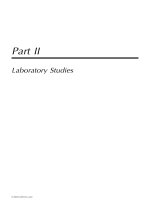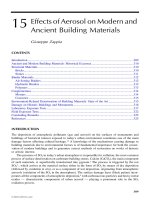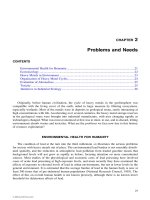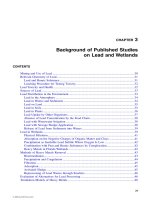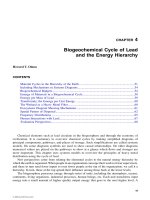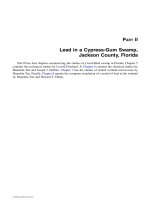Heavy Metals in the Environment - Chapter 7 pot
Bạn đang xem bản rút gọn của tài liệu. Xem và tải ngay bản đầy đủ của tài liệu tại đây (304.43 KB, 13 trang )
7
Environmental Aspects of Arsenic Toxicity
J. Thomas Hindmarsh
The University of Ottawa and the Ottawa Hospital, Ottawa, Ontario, Canada
Charles O. Abernathy
U.S. Environmental Protection Agency, Washington, D.C.
Gregory R. Peters
Philip Analytical Services Inc., Bedford, Nova Scotia, Canada
Ross F. McCurdy
InNOVAcorp, Dartmouth, Nova Scotia, Canada
1. INTRODUCTION
Arsenic is the 52nd most common element in the earth’s crust with an average
natural abundance of approximately 1.5–3 mg/kg. It is ubiquitous in the environ-
ment, occurring from both natural and anthropogenic sources, and both may pose
a threat to human health. Numerous control mechanisms for arsenic exist in the
environment but the natural cycling of this element throughout the various envi-
Copyright © 2002 Marcel Dekker, Inc.
ronmental compartments (air, water, soil, and biota) is complex and poorly under-
stood. The main sources of human exposure to arsenic are from the drinking
water supply and food.
A decade ago, it seemed that chronic arsenic poisoning was a rare and
diminishing problem. However, since then it has again emerged in parts of Asia
with unprecedented fury where tens of millions of people are exposed to toxic
levels in their drinking water, probably as a consequence of increased agricultural
irrigation. In recent years the toxic potential, both carcinogenic and noncarcino-
genic, of arsenic in drinking water has been intensely studied. However, further
research is needed to determine the toxic threshold for this element as well as
to understand the mechanisms governing the release of soluble arsenic into the
various environmental compartments and how this can be modified.
The health effects of environmental arsenic and its geochemistry have re-
cently been reviewed (1–3).
2. CHEMISTRY AND TOXICITY
Arsenic is a metalloid belonging to group 15 (old group 5) of the periodic table
(N, P, As, Sb, Bi). It exists predominantly in nature as the oxyanion with an
oxidation state of either (ϩ3) or (ϩ5); however, the (Ϫ3) state also exists in
other arsenic species. Arsenic binds covalently with most metals and nonmetals,
and it also forms stable organic compounds.
An important difference between arsenic and phosphorus (its neighbor in
the periodic table) is the stability of their esters to hydrolysis. Adenosine triphos-
phate (ATP) is relatively stable whereas the corresponding compound formed
with arsenate is easily hydrolyzed thereby uncoupling oxidative phosphorylation;
this accounts for the toxicity of arsenates in oxidative phosphorylation. Trivalent
arsenic compounds have an affinity for sulfur and this probably accounts for their
inhibition of a variety of enzymes such as pyruvate oxidase and 2-oxoglutarate
dehydrogenase. It has been proposed that the tumorigenic potential of arsenic
compounds may be related to the ability of some of them to form free radicals
(4).
Generally, trivalent arsenic compounds are more toxic than their pentava-
lent counterparts and inorganic arsenic compounds are more toxic than organ-
oarsenicals. Elemental arsenic is the least toxic form. Arsenobetaine and arseno-
choline (fish arsenic) are apparently virtually nontoxic. Arsenosugars are found
in marine algae and seaweeds (5). Some aryl-arsenicals have been used exten-
sively in the past as growth promoters for farm animals although these have been
largely replaced by antibiotics more recently. Melarsoprol is still used to treat
trypanosomiasis in humans. The formulae of some common arsenic compounds
are shown in Table 1.
Copyright © 2002 Marcel Dekker, Inc.
T
ABLE
1 Arsenic Compounds Relevant to
Human Toxicity
Arsenic trioxide As
2
O
3
Arsenous acid H
3
AsO
3
Arsenite H
2
AsO
3
1Ϫ
,HAsO
3
2Ϫ
,AsO
3
3Ϫ
Arsenic pentoxide As
2
O
5
Arsenic acid H
3
AsO
4
Arsenate H
2
AsO
4
1Ϫ
, HAsO
4
2Ϫ
,AsO
4
3Ϫ
Arsanilic acid C
6
H
4
NH
2
AsO(OH)
2
Arsenobetaine (CH
3
)
3
As
ϩ
CH
2
COO
Ϫ
Arsenocholine (CH
3
)
3
As
ϩ
CH
2
CH
2
OH
Dimethylarsinic acid (CH
3
)
2
AsO(OH)
Methylarsonic acid CH
3
AsO(OH)
2
Figure 1 outlines the global arsenic cycle, illustrating the cycling of arsenic
through the various environmental compartments.
3. NATURAL SOURCES
Arsenic occurs naturally in many minerals with FeAsS being the most common.
Although it is very stable and water insoluble as the arsenopyrite, this will readily
oxidize when exposed to air to yield compounds that are water soluble.
Little is known about the release of arsenic compounds into the atmospheric
compartment. Natural weathering and microbial action in the soil may release
volatile species into the air; also, volcanic activity may release some volatile
species and particles. However, these amounts are usually relatively small.
In soils, arsenic may exist in several forms. Soil has some self-cleansing
properties in that adsorption and coprecipitation of inorganic arsenic occurs onto
clay particles. Also, it forms insoluble precipitates with sulfur and soil cations,
particularly iron, as arsenopyrites.
In the water compartment, arsenic can be naturally introduced as a result of
erosion and weathering of rocks. Whereas anthropogenic sources can contribute
significantly to the content of surface water, groundwaters are, not surprisingly,
less commonly contaminated from this source and are more commonly contami-
nated by the natural weathering of arsenio-bearing minerals. In surface water,
arsenic can undergo a number of reactions, which include oxidation/reduction,
adsorption/precipitation, and methylation. Most surface water supplies have Eh
and pH levels (acid and oxidizing) that favor arsenate precipitation. Surface water
therefore has a self-cleansing action for arsenic as arsenite and more particularly
Copyright © 2002 Marcel Dekker, Inc.
F
IGURE
1 The global arsenic cycle. (From WT Piver. Biological and environmental effects, BA Fowler, ed., Top Environ.
Health 6:1, 1983. With permission.)
Copyright © 2002 Marcel Dekker, Inc.
arsenate form insoluble salts with dissolved or suspended cations (usually iron)
and these generally settle out in the sediments. Thus, much of the arsenic content
of surface water is usually present as insoluble particulates and sediment (6,7).
The relative significance of biomethylation in the surface water compartment is
uncertain.
In groundwater, the arsenic cycle has important toxicological implications.
Here, the more toxic reduced form, arsenite, is more prevalent (1,6). Unlike sur-
face water, deep groundwater generally has higher pH and low Eh levels and
this promotes the solubilization of arsenic released by weathering. As in surface
water, groundwater also can be self-cleansing. However, iron salts, the principal
agent with which arsenic combines, are often deficient because the increased pH
reduces their solubility.
The extensive use of groundwater for human consumption has led to mas-
sive outbreaks of severe chronic arsenic poisoning in South East Asia (Bengal,
Bangladesh, China, Taiwan) (8–11). In West Bengal, the most severe contamina-
tion was found in wells between 35 and 46 meters deep (12).
4. ANTHROPOGENIC SOURCES
The largest contributor to arsenic release in the environment is the mining and
smelting of nonferrous metals. The burning of fossil fuels follows next in signifi-
cance. The use of chromated copper arsenate as a wood preservative and the,
now substantially reduced, agricultural use of arsenic are lesser sources of envi-
ronmental contamination.
Arsenic is present in lead, copper, and gold ores and the smelting of these
releases arsenic as a gaseous emission with arsenic oxides as by-products. Al-
though these emissions account for 50–60% of total global contamination, their
effects are localized to regions around the smelters.
Although mining is not a major contributor to global contamination, sig-
nificant local contamination may occur from the arsenic-rich waste-rock tailings
when they become weathered and oxidized, and arsenic can then leach into the
soil and surface and groundwaters. The widespread use of these mine tailings as
fill around houses and for road construction can spread the contamination beyond
the limits of the mines. Surface runoff of the soluble arsenic species from waste-
rock tailings and from contamination of soils with arsenic-containing pesticides
can enter the surface water, but the self-cleansing action of this will often remove
it by precipitation as insoluble iron salts or by adsorption with clays, provided
the appropriate conditions prevail.
The arsenic content of North American coal is quite low (13). However,
the soft coals of eastern Europe can have very high arsenic contents and can
produce significant contamination in the fallout zones where this is burned (14).
The arsenic content of petroleum fuels is much lower than that of coal. However,
Copyright © 2002 Marcel Dekker, Inc.
because of the sheer quantity of these fuels that are burned, petroleum and oil
burning contributes substantially to global pollution.
5. HUMAN TOXICOLOGY
The following discussion will describe the toxic effects of the long-term con-
sumption of small amounts of arsenic by mouth derived from the drinking water
supply or from medications such as Fowler’s solution (1% potassium arsenite).
The carcinogenic effect (lung cancer) of the chronic inhalation of arsenic trioxide
dust is well established. Little or no arsenic can be absorbed through the intact
skin.
5.1 Chronic Arsenic Poisoning—General Effects
Arsenic interferes with enzyme action, DNA transcription, and metabolism.
Therefore, it is not surprising that its effects upon the body are protean. These
include chronic weakness, general debility and lassitude, loss of appetite and
energy, loss of weight, and sometimes a degree of dementia. Anemia, probably
due to bone marrow suppression (normochromic and normocytic), is common
and leukopenia may also occur. Basophilic stippling of the erythrocytes may be
present and megaloblastic changes have been reported as have disorders of heme
synthesis (1,6).
Noncirrhotic (presinusoidal) portal hypertension is a rare and relatively spe-
cific hepatic manifestation of chronic arsenic exposure (15), which may be the
consequence of arsenic-induced vascular endothelial injury (16).
5.2 Dermatological Effects
The skin manifestations of chronic arsenic poisoning are hyperpigmentation and
hypopigmentation, progressing to palmar/plantar hyperkeratoses in which skin
cancer often subsequently develops (6). The hyperpigmentation develops around
hypopigmented macules: the characteristic raindrop pattern. Diffuse pigmenta-
tion is more pronounced in the axillae and groin. The hyperkeratoses develop on
the palms of the hands and the soles of the feet and, often, raised wart-like kerato-
ses project from the surface or from the sides of the fingers. Hyperpigmentation
may first appear 6 months to 2 years after onset of exposure in excess of 0.04
mg/kg/day; lower exposure rates can take longer. Palmar and plantar hyperkera-
toses take several years to develop (1).
5.3 Cardiovascular Effects
Chronic arsenic exposure is associated with an increased prevalence of peripheral
vascular disease, which in extreme examples can produce peripheral gangrene,
Copyright © 2002 Marcel Dekker, Inc.
the consequence of thromboangiitis obliterans, in small-limb vessels (blackfoot
disease). Also, there appears to be a similar but less pronounced association be-
tween arsenic exposure and hypertension and cardiovascular disease.
5.4 Neurological Effects
Chronic arsenic exposure commonly produces central and peripheral nervous sys-
tem impairment, and histological examination of the peripheral nerves in such
cases reveals a sensorimotor axonopathy (17). The peripheral neuropathy is often
largely confined to the arms and legs and is usually more pronounced distally.
Paresthesia is often troublesome. Sensory impairment is commonly more pro-
nounced than motor effects, and the legs are often more severely affected than
the arms. The features are often severe and slow to recover (17,18). There is
convincing experimental work in animals supporting the concept that arsenic has
an immunomodulating effect (19,20) and this may explain the effectiveness of
arsenic-containing medications in treating asthma in humans. There is also animal
evidence that it is teratogenic and mutagenic (1).
Inorganic arsenic is detoxified in the human by methylation to monomethyl
arsonic and dimethyl arsenic acids (the latter the most prevalent) and these are
excreted in the urine. This process is impaired, at least in rabbits whose diets are
deficient in methyl donors (methionine, choline) and protein (21). Thus, deficient
diets have the potential to aggravate arsenic toxicity.
5.5 Cancer Effects
The association of chronic arsenic ingestion and skin cancer (intraepidermal car-
cinoma, Bowen’s disease), squamous cell carcinoma, and superficial multicentric
basal cell carcinoma is long established. Also associated are bladder cancer and
angiosarcoma of the liver, and probably also renal carcinoma. The relationship
between arsenic inhalation and lung cancer is well known but there now seems
to be a clear association between arsenic ingestion (from the drinking water sup-
ply) and the increased prevalence of lung cancer in humans (1).
The lack of an animal model has hampered investigation of potential mech-
anisms of the tumorigenic action of arsenic. A recent study in mice reported that
the administration of arsenate (500 µg/L) induced tumors of the gastrointestinal
tract, lung, liver, spleen, bone, skin, reproductive tract, and eye (22). However,
more work is needed prior to accepting this model for studying arsenic-induced
carcinogenicity. Although there is no accepted mode of action for arsenic, it
has been established that arsenic does not directly react with DNA and cause
point mutations in bacterial or mammalian cells (1,23). There are several poten-
tial ways that arsenic could cause cancers. For example, administration of
arsenic or dimethylarsinic acid (DMA, a metabolite of inorganic arsenic) can
increase oxidative stress, a putative mechanism for induction of cancer (1,4).
Copyright © 2002 Marcel Dekker, Inc.
Other authors have reported that arsenic can alter gene expression by altering
gene methylation: Mass and Wang (24) found that arsenic caused a dose-
response-related hypermethylation in human lung adenocarcinoma cells. On the
other hand, Zhao et al. (25) reported that arsenic could transform a rat liver epithe-
lial cell line into one that could cause tumors in mice and concluded that hypo-
methylation of DNA was a potential mechanism for arsenic-induced cancer.
Since alterations in methylation patterns could affect DNA metabolism such
changes could affect gene expression. In addition, arsenic can also affect cell
proliferation (26). Although each of the above mechanisms could induce cancer,
more work is necessary prior to accepting these or other theories on the mecha-
nism of arsenic-induced cancers.
6. SOURCES OF HUMAN EXPOSURE
Apart from persons working in nonferrous metal smelters and those living near
these (and also near electricity-generating stations burning heavily arsenic-con-
taminated soft coal), the major exposure of the general public to arsenic is from
ingestion from their drinking water and food supply. Arsenic is found in large
amounts in some soils and rock formations but is relatively inert, and unless it
enters the drinking water supply, it is harmless.
6.1 Exposure from Food
As a generalization, provided the drinking water supply is uncontaminated, then
the risk of eating vegetables grown in arsenic-contaminated water seems to be
small; there is no well-documented evidence that they cause a risk. In root vegeta-
bles and fruits, much of the arsenic tends to migrate to the outer surface and is
removed in washing and peeling. However, this is an underresearched area and
is the subject of active investigation at the present time. It has been recently
reviewed (1,27–29).
Of concern is the amount of arsenic ingested from rice and other foods
in the diet, grown in the heavily arsenic-contaminated waters of parts of south-
east Asia. Few data are available on this but two studies from Taiwan (30,31)
report rice arsenic contents of 0.15 mg/kg and 0.7 mg/kg, the former diet pro-
viding a calculated daily intake of approximately 19 µg/ (plus 31 µg from
yams). This intake would be the equivalent of ingesting 1 L of drinking water
containing arsenic at the widely accepted standard of 50 µg/L. Speciation of
arsenic in food has repeatedly shown it to be predominantly inorganic (arsenate
and arsenite).
Large amounts of arsenic are found in fish and shellfish (arsenocholine,
arsenobetaine) but these are apparently nontoxic and are mostly excreted un-
Copyright © 2002 Marcel Dekker, Inc.
changed in the urine (32). Thus, when using urine arsenic measurements to assess
exposure, it is necessary to fractionate the arsenic species (33).
6.2 Drinking Water
Most large-scale episodes of chronic arsenic poisoning have resulted from arsenic
contamination of drinking water. However, none have been so large as the current
outbreaks in southeast Asia (Bengal, Bangladesh, China, Taiwan). The data
from Taiwan and from Mexico, Argentina, and Chile on large numbers of people
subjected to high levels of drinking-water arsenic have provided opportuni-
ties to delineate the risks of excess drinking-water arsenic. The largest study
reviewed 40,421 persons using contaminated water, compared with 7500 controls
(11,34,35).
The toxic threshold, if one exists for humans, is heatedly debated. Sto
¨
hrer
(36) has reviewed the extensive data from Taiwan and elsewhere and has con-
cluded that skin cancers, internal cancers, and noncancerous effects of arsenic
have approximately the same ‘‘threshold’’ and that these decrease sharply when
the intake falls below 400 µg/day, and that the disease potential above this level
is well established. Other researchers have reported data from human studies that
suggest that adverse health effects occur below 400 µg/day. In Utah, Lewis et
al. (37) examined the effects of arsenic in drinking water at concentrations under
200 µg/L. They found increases in mortality from prostate cancer, hypertensive
heart disease, nephrosis, and nephritis in males and in hypertensive heart disease
and in all other heart disease categories in females. In their review of epidemio-
logical evidence for a threshold, Smith et al. (38) state that most human studies
do not provide any data supporting a threshold for arsenic. The problem associ-
ated with establishing a threshold for arsenic is that the current epidemiology
studies are ecological in nature (no individual exposure data are provided) and,
as such, are poorly suited for this task. Although the in vitro studies all indicate
that arsenic may mediate its effects through mechanisms that would give subli-
near curves (1), there is no accepted mode of action for the deleterious actions
of arsenic. Studies examining the effects of arsenic in drinking water at concentra-
tions of 10–200 µg/L or acceptance of mechanism(s) of action for arsenic are
necessary to resolve this question. Thus the risks of ingesting water with a content
that provides an arsenic intake of less than 400 µg/day are unresolved and have
been the target of extensive study by the U.S. Environmental Protection Agency
and the U.S. National Research Council, who have used the above data in an
attempt to determine the upper limit of acceptable arsenic content for drinking
water for the United States (39–41).
The U.S. National Research Council has constructed several models to as-
sess toxicity at low concentration in drinking water including extrapolation of
Copyright © 2002 Marcel Dekker, Inc.
the dose-response curve to the left, assuming it is linear. Their deliberations have
recently resulted in a major report, a detailed description of which is beyond the
scope of this chapter (1). In general, allowing for the difference in water intake
and weight between Taiwanese and U.S. residents, their conclusion was that each
microgram of inorganic arsenic per liter in the drinking water might increase the
lifetime risk of skin cancer by three to seven additional cases per 100,000 persons,
or approximately one to five additional cases per 1000 persons consuming water
with an arsenic content of 50 µg/L. However, the authors recognize the limita-
tions of this information, which is based on ecological studies, and also that the
dose-response curve below the level of observed effects may not be linear and
that the risk may well be less than that implied by linear extrapolation. It should
also be remembered that skin cancer is an eminently treatable disease. The risk
data on other cancers is more complex.
The purpose for recommending or instituting regulatory limits for a chemi-
cal in drinking water is ideally to prevent or at least decrease the occurrence of
adverse health effects after consumption of water containing that chemical. One
of the first considerations is whether the chemical causes adverse human health
effects. The World Health Organization (WHO), Canada, and the U.S. EPA have
all classified arsenic as a human carcinogen. At the present time, WHO and Can-
ada have published recommendations for arsenic in drinking water, while the
United States is in the process of proposing a regulatory level. WHO (42) pro-
posed an arsenic guideline value of 10 µg/L based on occurrence of skin cancer
and analytical techniques, whereas Canada set an interim maximum arsenic con-
centration of 25 µg/L based on estimated lifetime cancer risk, the practical quanti-
tation limit (PQL), and practical treatment technology (43). In its arsenic pro-
posal, the U.S. EPA selects the most appropriate health effect and establishes a
PQL, considering the costs of treatments, the water system size, and the numbers
of persons exposed to various concentrations of arsenic (44). The U.S. EPA used
the bladder cancer analysis from the NRC report (1999) (1) for the health effect.
They calculated a 1% effective dose of approximately 400 µg/L. Since there is
no accepted mode of action for arsenic, a maximum contaminant level goal
(MCLG) of zero was selected for arsenic. The MCLG is a health goal and is
nonregulatory in nature. After considering various analytical techniques, a PQL
of 3 µg/L was selected. The PQL is the value that can be measured in a commer-
cial analytical lab and sets the lowest value for the maximum contaminant level
(MCL—an enforceable regulatory value). The treatment technique and cost of
implementation will depend on the size of the drinking water system. After con-
sidering the health effects, PQL, costs of treatment, and stakeholder input, the
U.S. EPA proposed an MCL for arsenic of 5 µg/L and will consider comments on
3, 10, and 20 µg/L. In January 2001, the U.S. EPA was scheduled to promulgate a
final MCL after considering the comments of the stakeholders on the proposal.
Copyright © 2002 Marcel Dekker, Inc.
7. CONCLUSION
Arsenic is ubiquitous and a potent environmental hazard to humans if it enters
the drinking-water supply. Further work is necessary to determine the factors
governing its movement through the various environmental compartments, and
to delineate the possible toxic effects of low intakes.
REFERENCES
1. RA Goyer, HV Aposhian, KG Brown, et al. National Research Council. Arsenic in
Drinking Water. Washington, DC: National Academy Press, 1999.
2. WR Chappell, CO Abernathy, RL Calderon, eds. Arsenic Exposure and Health Ef-
fects. Amsterdam: Elsevier, 1999.
3. CO Abernathy, RL Calderon, WR Chappell. Arsenic and Health Effects. London:
Chapman & Hall, 1997.
4. K Yamanaka, K Ohtsubo, A Hasegawa. Exposure to dimethylarsenic acid, a main
metabolite of inorganic arsenic, strongly promotes tumorigenesis initiated by 4-nitro-
quinolone 1 oxide in the lungs of mice. Carcinogenesis 17:767–770, 1996.
5. XC Lee, M Ma, VWM Lai. Exposure to arsenosugars from seafood ingestion and
speciation of urinary arsenic metabolites. In: WR Chappell, CO Abernathy, RL
Calderon, eds. Arsenic Exposure and Health Effects. Amsterdam: Elsevier, 1999,
pp 69–79.
6. JT Hindmarsh, RF McCurdy. Clinical and environmental aspects of arsenic toxicity.
Crit Rev Clin Lab Sci 23:315–347, 1986.
7. GR Peters, RF McCurdy, JT Hindmarsh. Environmental aspects of arsenic toxicity.
Crit Rev Clin Lab Sci 33:457–494, 1996.
8. DNG Mazumder, BK De, A Santra, et al. Chronic arsenic toxicity: epidemiology,
natural history and treatment. In: WR Chappell, CO Abernathy, RL Calderon, eds.
Arsenic Exposure and Health Effects. Amsterdam: Elsevier, 1999, pp 335–347.
9. UK Chowdhury, BK Biswas, RK Dhar, et al. Groundwater contamination and suffer-
ing of people in Bangladesh. In: WR Chappell, CO Abernathy, RL Calderon, eds.
Arsenic Exposure and Health Effects. Amsterdam: Elsevier, 1999, pp 165–182.
10. GF Sun, GJ Dai, FJ Li, et al. The present situation of chronic arsenism and research
in China. In: WR Chappell, CO Abernathy, RL Calderon, eds. Arsenic Exposure
and Health Effects. Amsterdam: Elsevier, 1999, pp 123–126.
11. WP Tseng, HM Chu, SW How, et al. Prevalence of skin cancer in an endemic area
of chronic arsenicalism in Taiwan. J Natl Cancer Inst 40:453–463, 1968.
12. KS Subramanian, MJ Kosnett. Human exposures to arsenic from consumption of
well water in West Bengal, India. Int J Occup Environ Health 4:217–230, 1998.
13. JW Yager, HJ Clewell, JB Hicks, et al. Airborne exposure to arsenic occurring in
coal fly ash. In: WR Chappell, CO Abernathy, RL Calderon, eds. Arsenic Exposure
and Health Effects. Amsterdam: Elsevier, 1999, pp 19–30.
14. V Benko, K Simon. Health aspects of burning coal with a high arsenic content.
Environ Res 13:378–385, 1977.
Copyright © 2002 Marcel Dekker, Inc.
15. F Nevens, J Fevery, W Van Sleenbergen, et al. Arsenic and non-cirrhotic portal
hypertension. J Hepatol 11:80–85, 1990.
16. H Labadie, P Stoessel, P Callard, et al. Hepatic venoocclusive disease and perisinu-
soidal fibrosis secondary to arsenic poisoning. Gastroenterology 99:1140–1143,
1990.
17. PM Le Quesne, JG McLeod. Peripheral neuropathy following a simple exposure to
arsenic. J Neurol Sci 32:437–451, 1977.
18. AJB Heyman, RW Pfeiffer, RW Willett, et al. Peripheral neuropathy caused by ar-
senical intoxication: a study of 41 cases. N Engl J Med 254:401–409, 1956.
19. ME Gonseblatt, L Vega, LA Herrera, et al. Inorganic arsenic effects on human lym-
phocyte stimulation and proliferation. Mutat Res 283:91–95, 1992.
20. ME Gonseblatt, L Vega, R Montero, et al. Lymphocyte replicating ability in individ-
uals exposed to arsenic in drinking water. Mutat Res 313:293–299, 1994.
21. M Vahter, E Marafante. Effects of low dietary intake of methionine, choline, or
protein on the biotransformation of arsenite in the rabbit. Toxicol Lett 37:41–46,
1987.
22. JS Ng, AA Seawright, L Qi, et al. Tumours in mice induced by exposure to sodium
arsenate in drinking water. In: WR Chappell, CO Abernathy, RL Calderon, eds.
Arsenic Exposure and Health Effects. Amsterdam: Elsevier, 1999, pp 217–223.
23. TG Rossman. Molecular and genetic toxicology of arsenic. Environ Toxicol 17:171–
187, 1998.
24. M Mass, L Wang. Arsenic alters cytosine methylation patterns of the promoter of
the tumor suppressor gene p53 in human lung cells. Mutat Res 386:263–277,
1997.
25. CQ Zhao, MR Young, BA Diwan, et al. Association of arsenic-induced malignant
transformation with DNA hypomethylation and aberrant gene expression. Proc Natl
Acad Sci USA 94:10907–10912, 1999.
26. DR Germolic, J Spaulding, GA Boorman, et al. Arsenic can mediate skin neoplasia
by chronic stimulation of keratinocyte-derived growth factors. Mutat Res 386:209–
218, 1997.
27. RW Dabeka, AD McKenzie, GMA Lacroix. Survey of arsenic in total diet food
composites and estimation of the dietary intake of arsenic by Canadian adults and
children. JAOA Int 76:14–25, 1993.
28. MA Adams, PM Bolger, EL Gunderson. Dietary intake and hazards of arsenic. In:
WR Chappell, CO Abernathy, CR Cothern, eds. Arsenic Exposure and Health.
Northwood, UK: Science & Technol Lett, 1994, pp 41–49.
29. RA Schoof, J Eickhoff, LJ Yost, et al. Dietary exposure to inorganic arsenic. In: WR
Chappell, CO Abernathy, RL Calderon, eds. Arsenic Exposure and Health Effects.
Amsterdam: Elsevier, 1999, pp 81–88.
30. GC Li, WC Fei, YP Yen. Survey of arsenic residual levels in the rice grain from
various locations in Taiwan. Natl Sci Council Monthly 7:700–706, 1979.
31. RA Schoof, LJ Yost, E Crecelius, et al. Dietary arsenic intake in Taiwanese districts
with elevated arsenic in drinking water. Hum Ecol Risk Anal 4:117–135, 1998.
32. JM Donohue, CO Abernathy. Exposure to inorganic arsenic from fish and shellfish.
In: WR Chappell, CO Abernathy, RL Calderon, eds. Arsenic Exposure and Health
Effects. Amsterdam: Elsevier, 1999, pp 89–98.
Copyright © 2002 Marcel Dekker, Inc.
33. M Vahter. What are the chemical forms of arsenic in urine and what can they tell
us about exposure. Clin Chem 40:679–680, 1994.
34. WP Tsen. Effects and dose-response relationship of skin cancer and blackfoot dis-
ease with arsenic. Environ Health Perspect 19:109–119, 1977.
35. CJ Chen, TL Kuo, MM Wu. Arsenic and cancer (letter). Lancet 1:414–415, 1988.
36. G Sto
¨
hrer. Arsenic: opportunity for risk assessment. Arch Toxicol 65:525–531,
1991.
37. DR Lewis, JW Southwick, R Oullet-Hellstrom, et al. Drinking water arsenic in Utah:
a cohort mortality study. Environ Health Perspect 107:359–365, 1999.
38. AH Smith, ML Biggs, L Moore, et al. Cancer risks from arsenic in drinking water:
implications for drinking water standards. In: WR Chappell, CO Abernathy, RL
Calderon, eds. Arsenic Exposure and Health Effects. Amsterdam: Elsevier, 1999,
pp 191–199.
39. Special Report on Ingested Inorganic Arsenic: Skin Cancer; Nutritional Essentiality.
PA 625/3-87/013. U.S. Environmental Protection Agency, Risk Assessment Forum,
Washington, DC, 1988.
40. CO Abernathy, WR Chappell, ME Meek. Is ingested inorganic arsenic a threshold
carcinogen? Fund Appl Toxicol 29:168–175, 1996.
41. KG Brown, KE Boyle, CW Chen, et al. A dose-response analysis of skin cancer
from inorganic arsenic in drinking water. Risk Anal 9:519–528, 1989.
42. WHO (World Health Organization). Guidelines for Drinking-Water Quality. Vol 2.
Health Criteria and Other Supporting Information. Arsenic, 2nd ed. Geneva: World
Health Organization, 1996, pp 156–167.
43. Health Canada. Guidelines for Canadian Drinking Water Quality. Supporting docu-
mentation, Arsenic. Feb 1989 (edited Aug 1992). Ottawa, Canada, 1996.
44. CO Abernathy, IS Dooley, J Taft, et al. Arsenic: moving toward a regulation. In:
H Salem, EJ Olajos, eds. Toxicology in Risk Assessment. Philadelphia: Taylor &
Francis, 2000, pp 211–222.
Copyright © 2002 Marcel Dekker, Inc.



